Report on Effective Information Handling and Supporting Carers (DHS)
VerifiedAdded on 2022/12/29
|14
|2700
|32
Report
AI Summary
This report explores effective information handling in care settings, focusing on data protection, legal requirements, and the roles and responsibilities of professional nurses. It covers topics such as record maintenance, patient care, and the importance of up-to-date and accurate information. The report also delves into person-centered care, active participation, and consent, highlighting the importance of individual rights and well-being in healthcare. Furthermore, it discusses the duties of professional nurses, including maintaining hygiene, administering medications, and providing emotional support. The report emphasizes the need for effective communication, feedback, and continuous personal development to improve the quality of care and support for both patients and carers. It also covers the importance of identity, self-esteem, and self-image in promoting well-being within a care setting.

Promote effective
handling of information in
care settings, support
carers to meet the care
needs of individuals
handling of information in
care settings, support
carers to meet the care
needs of individuals
Paraphrase This Document
Need a fresh take? Get an instant paraphrase of this document with our AI Paraphraser
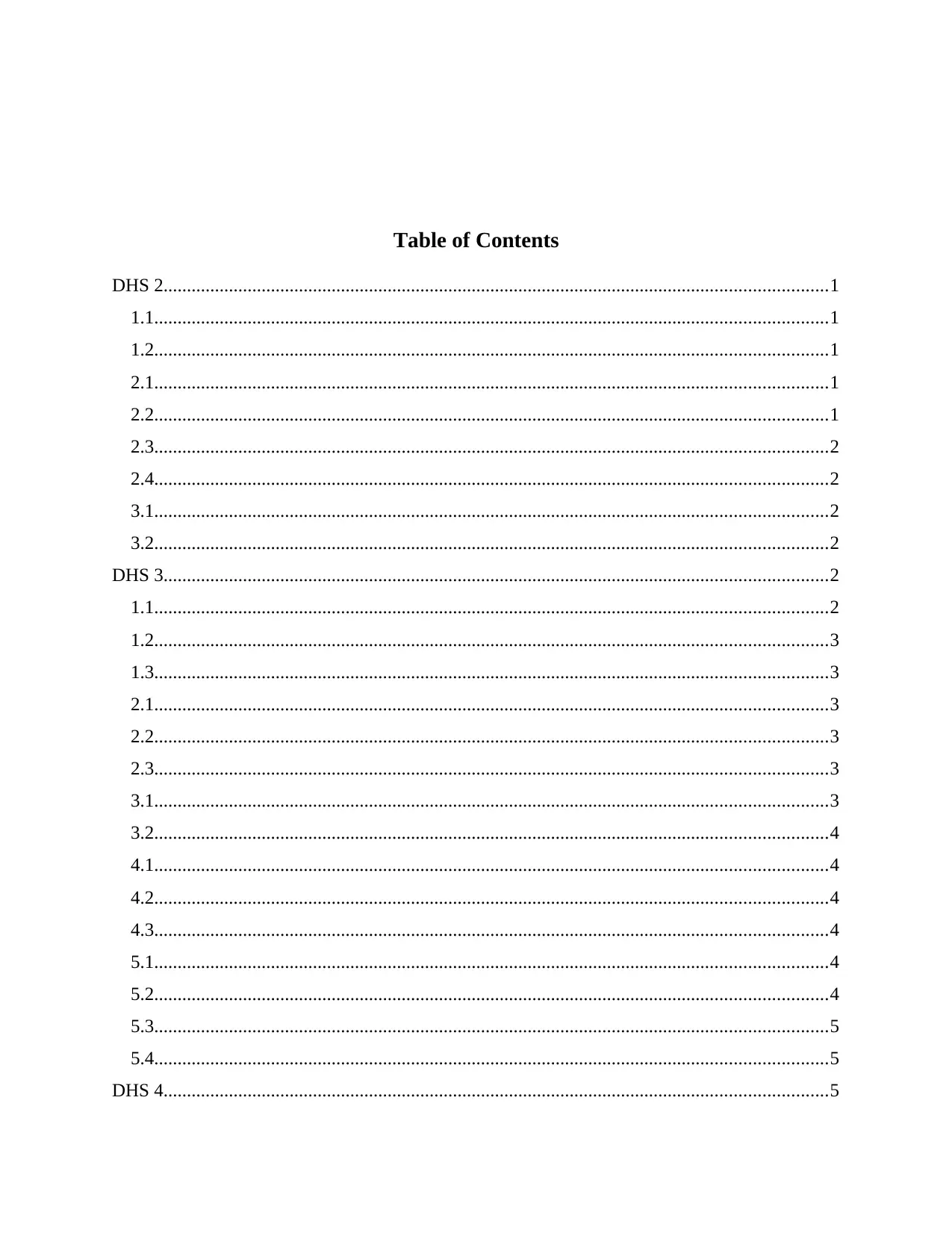
Table of Contents
DHS 2..............................................................................................................................................1
1.1................................................................................................................................................1
1.2................................................................................................................................................1
2.1................................................................................................................................................1
2.2................................................................................................................................................1
2.3................................................................................................................................................2
2.4................................................................................................................................................2
3.1................................................................................................................................................2
3.2................................................................................................................................................2
DHS 3..............................................................................................................................................2
1.1................................................................................................................................................2
1.2................................................................................................................................................3
1.3................................................................................................................................................3
2.1................................................................................................................................................3
2.2................................................................................................................................................3
2.3................................................................................................................................................3
3.1................................................................................................................................................3
3.2................................................................................................................................................4
4.1................................................................................................................................................4
4.2................................................................................................................................................4
4.3................................................................................................................................................4
5.1................................................................................................................................................4
5.2................................................................................................................................................4
5.3................................................................................................................................................5
5.4................................................................................................................................................5
DHS 4..............................................................................................................................................5
DHS 2..............................................................................................................................................1
1.1................................................................................................................................................1
1.2................................................................................................................................................1
2.1................................................................................................................................................1
2.2................................................................................................................................................1
2.3................................................................................................................................................2
2.4................................................................................................................................................2
3.1................................................................................................................................................2
3.2................................................................................................................................................2
DHS 3..............................................................................................................................................2
1.1................................................................................................................................................2
1.2................................................................................................................................................3
1.3................................................................................................................................................3
2.1................................................................................................................................................3
2.2................................................................................................................................................3
2.3................................................................................................................................................3
3.1................................................................................................................................................3
3.2................................................................................................................................................4
4.1................................................................................................................................................4
4.2................................................................................................................................................4
4.3................................................................................................................................................4
5.1................................................................................................................................................4
5.2................................................................................................................................................4
5.3................................................................................................................................................5
5.4................................................................................................................................................5
DHS 4..............................................................................................................................................5
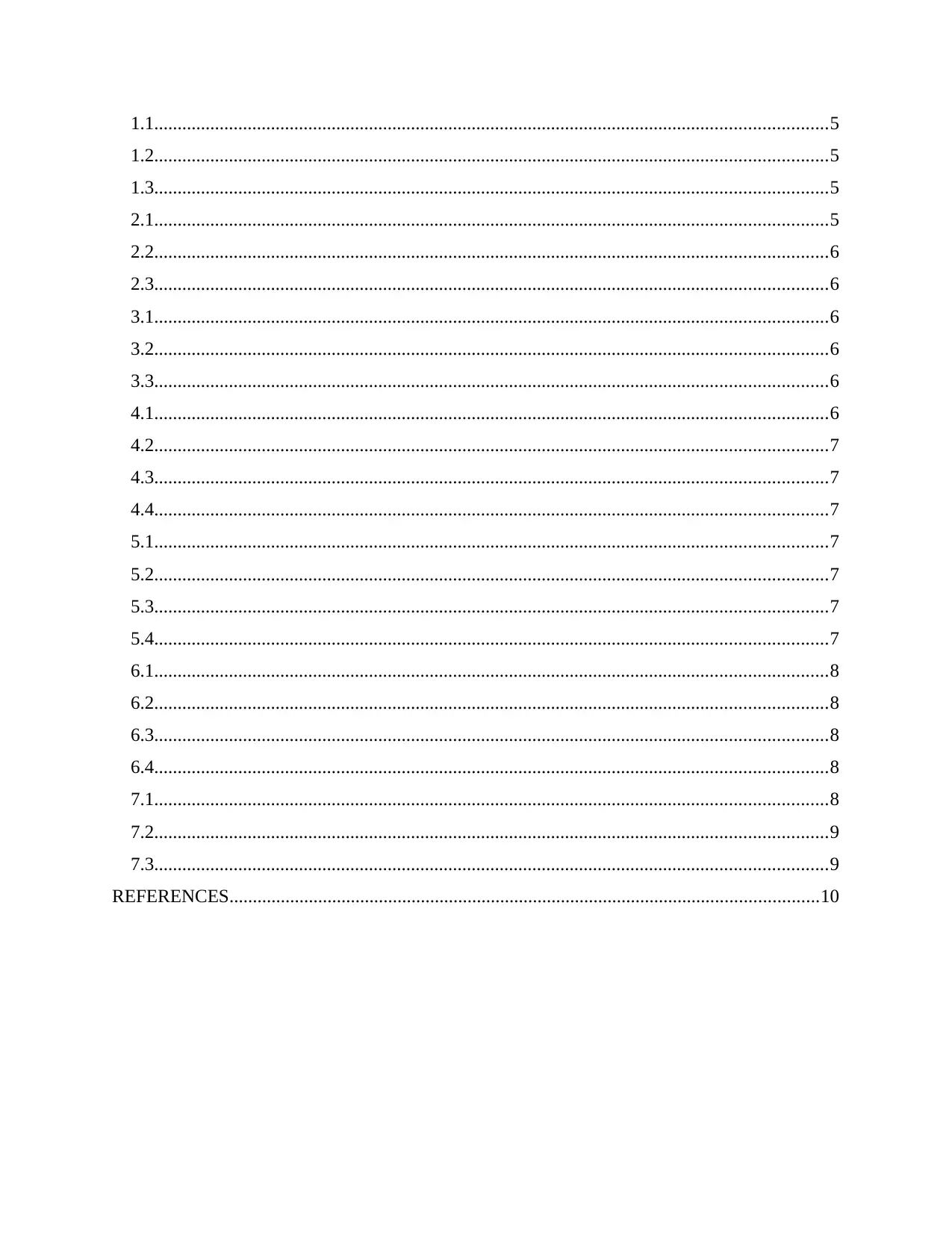
1.1................................................................................................................................................5
1.2................................................................................................................................................5
1.3................................................................................................................................................5
2.1................................................................................................................................................5
2.2................................................................................................................................................6
2.3................................................................................................................................................6
3.1................................................................................................................................................6
3.2................................................................................................................................................6
3.3................................................................................................................................................6
4.1................................................................................................................................................6
4.2................................................................................................................................................7
4.3................................................................................................................................................7
4.4................................................................................................................................................7
5.1................................................................................................................................................7
5.2................................................................................................................................................7
5.3................................................................................................................................................7
5.4................................................................................................................................................7
6.1................................................................................................................................................8
6.2................................................................................................................................................8
6.3................................................................................................................................................8
6.4................................................................................................................................................8
7.1................................................................................................................................................8
7.2................................................................................................................................................9
7.3................................................................................................................................................9
REFERENCES..............................................................................................................................10
1.2................................................................................................................................................5
1.3................................................................................................................................................5
2.1................................................................................................................................................5
2.2................................................................................................................................................6
2.3................................................................................................................................................6
3.1................................................................................................................................................6
3.2................................................................................................................................................6
3.3................................................................................................................................................6
4.1................................................................................................................................................6
4.2................................................................................................................................................7
4.3................................................................................................................................................7
4.4................................................................................................................................................7
5.1................................................................................................................................................7
5.2................................................................................................................................................7
5.3................................................................................................................................................7
5.4................................................................................................................................................7
6.1................................................................................................................................................8
6.2................................................................................................................................................8
6.3................................................................................................................................................8
6.4................................................................................................................................................8
7.1................................................................................................................................................8
7.2................................................................................................................................................9
7.3................................................................................................................................................9
REFERENCES..............................................................................................................................10
⊘ This is a preview!⊘
Do you want full access?
Subscribe today to unlock all pages.

Trusted by 1+ million students worldwide

Paraphrase This Document
Need a fresh take? Get an instant paraphrase of this document with our AI Paraphraser
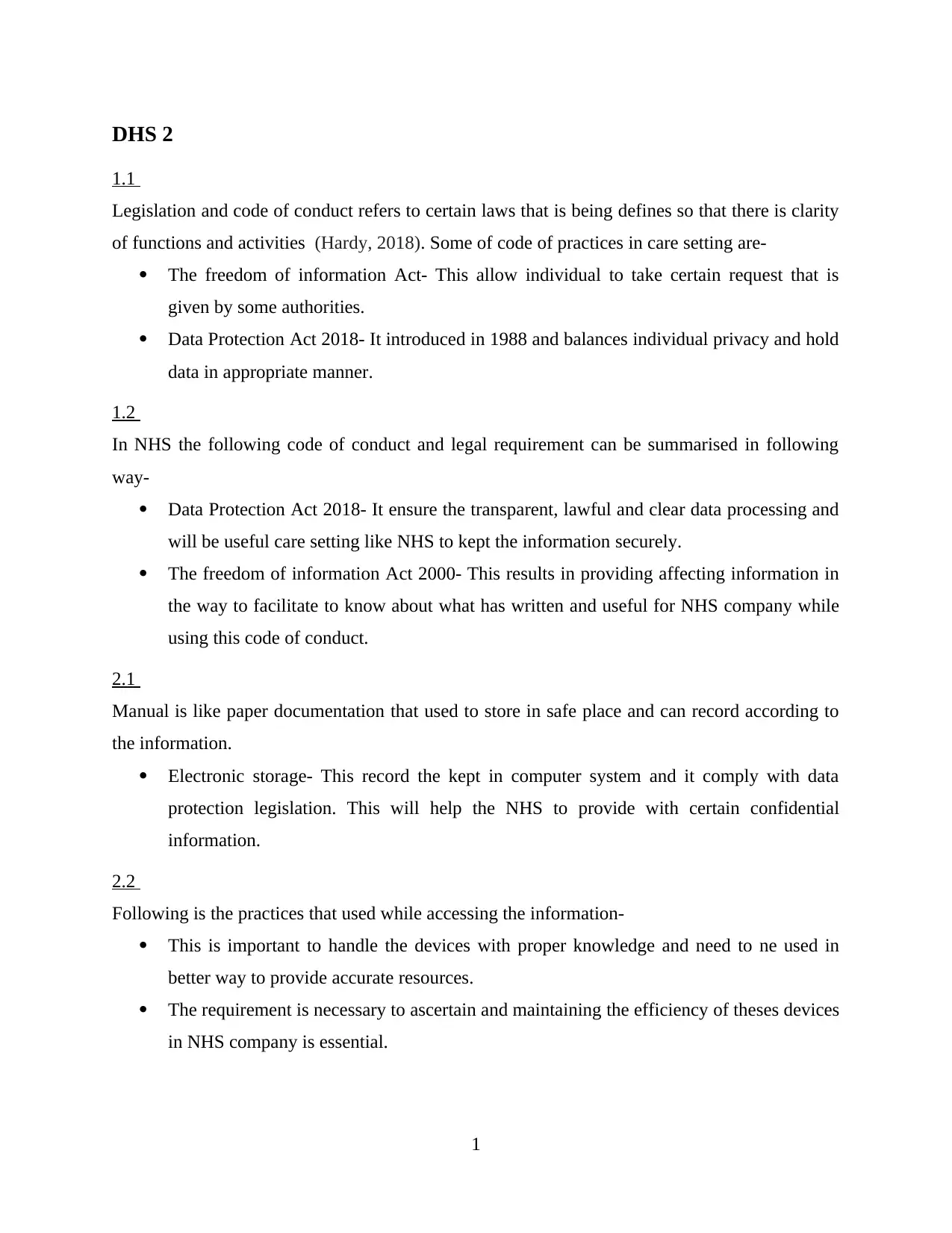
DHS 2
1.1
Legislation and code of conduct refers to certain laws that is being defines so that there is clarity
of functions and activities (Hardy, 2018). Some of code of practices in care setting are-
The freedom of information Act- This allow individual to take certain request that is
given by some authorities.
Data Protection Act 2018- It introduced in 1988 and balances individual privacy and hold
data in appropriate manner.
1.2
In NHS the following code of conduct and legal requirement can be summarised in following
way-
Data Protection Act 2018- It ensure the transparent, lawful and clear data processing and
will be useful care setting like NHS to kept the information securely.
The freedom of information Act 2000- This results in providing affecting information in
the way to facilitate to know about what has written and useful for NHS company while
using this code of conduct.
2.1
Manual is like paper documentation that used to store in safe place and can record according to
the information.
Electronic storage- This record the kept in computer system and it comply with data
protection legislation. This will help the NHS to provide with certain confidential
information.
2.2
Following is the practices that used while accessing the information-
This is important to handle the devices with proper knowledge and need to ne used in
better way to provide accurate resources.
The requirement is necessary to ascertain and maintaining the efficiency of theses devices
in NHS company is essential.
1
1.1
Legislation and code of conduct refers to certain laws that is being defines so that there is clarity
of functions and activities (Hardy, 2018). Some of code of practices in care setting are-
The freedom of information Act- This allow individual to take certain request that is
given by some authorities.
Data Protection Act 2018- It introduced in 1988 and balances individual privacy and hold
data in appropriate manner.
1.2
In NHS the following code of conduct and legal requirement can be summarised in following
way-
Data Protection Act 2018- It ensure the transparent, lawful and clear data processing and
will be useful care setting like NHS to kept the information securely.
The freedom of information Act 2000- This results in providing affecting information in
the way to facilitate to know about what has written and useful for NHS company while
using this code of conduct.
2.1
Manual is like paper documentation that used to store in safe place and can record according to
the information.
Electronic storage- This record the kept in computer system and it comply with data
protection legislation. This will help the NHS to provide with certain confidential
information.
2.2
Following is the practices that used while accessing the information-
This is important to handle the devices with proper knowledge and need to ne used in
better way to provide accurate resources.
The requirement is necessary to ascertain and maintaining the efficiency of theses devices
in NHS company is essential.
1
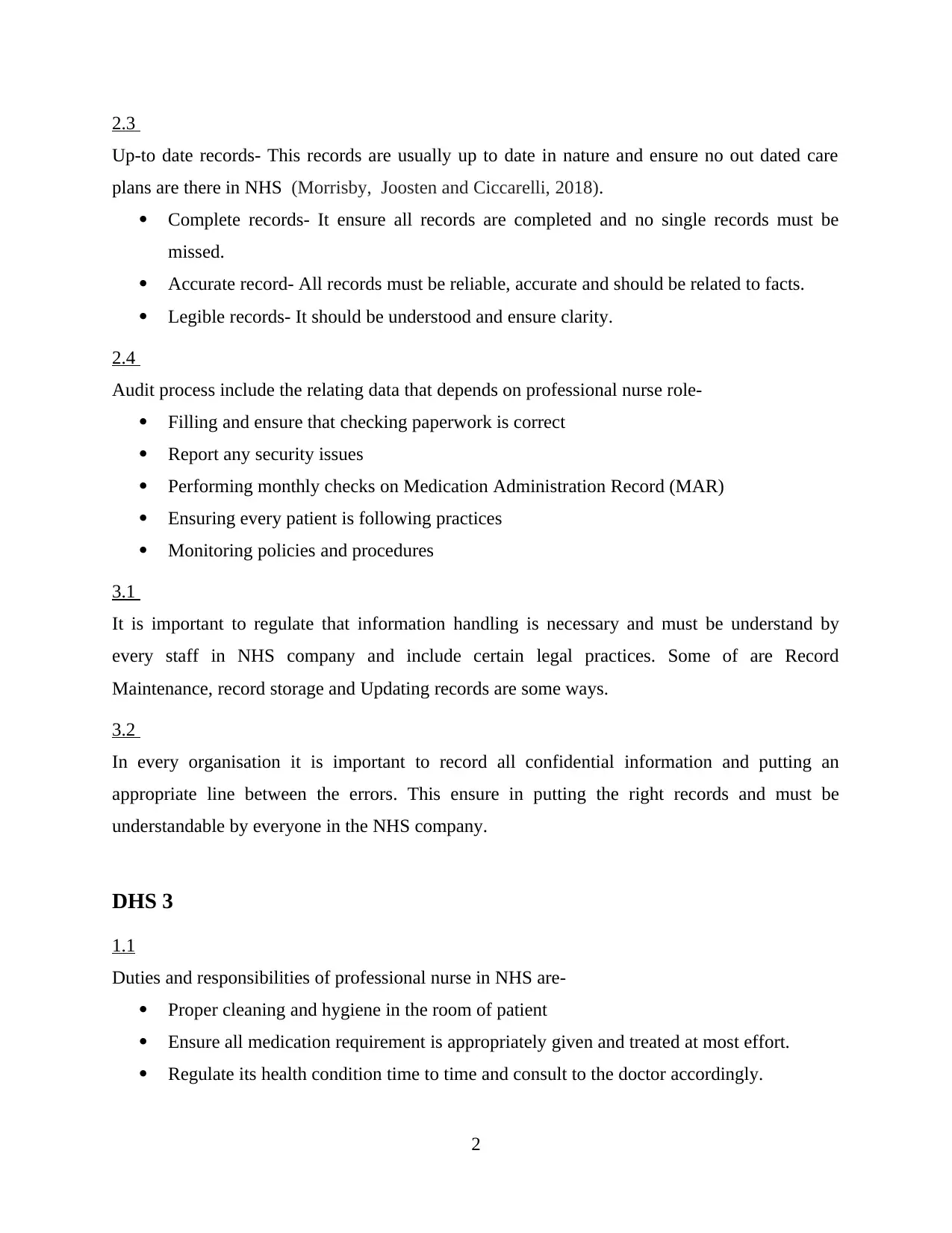
2.3
Up-to date records- This records are usually up to date in nature and ensure no out dated care
plans are there in NHS (Morrisby, Joosten and Ciccarelli, 2018).
Complete records- It ensure all records are completed and no single records must be
missed.
Accurate record- All records must be reliable, accurate and should be related to facts.
Legible records- It should be understood and ensure clarity.
2.4
Audit process include the relating data that depends on professional nurse role-
Filling and ensure that checking paperwork is correct
Report any security issues
Performing monthly checks on Medication Administration Record (MAR)
Ensuring every patient is following practices
Monitoring policies and procedures
3.1
It is important to regulate that information handling is necessary and must be understand by
every staff in NHS company and include certain legal practices. Some of are Record
Maintenance, record storage and Updating records are some ways.
3.2
In every organisation it is important to record all confidential information and putting an
appropriate line between the errors. This ensure in putting the right records and must be
understandable by everyone in the NHS company.
DHS 3
1.1
Duties and responsibilities of professional nurse in NHS are-
Proper cleaning and hygiene in the room of patient
Ensure all medication requirement is appropriately given and treated at most effort.
Regulate its health condition time to time and consult to the doctor accordingly.
2
Up-to date records- This records are usually up to date in nature and ensure no out dated care
plans are there in NHS (Morrisby, Joosten and Ciccarelli, 2018).
Complete records- It ensure all records are completed and no single records must be
missed.
Accurate record- All records must be reliable, accurate and should be related to facts.
Legible records- It should be understood and ensure clarity.
2.4
Audit process include the relating data that depends on professional nurse role-
Filling and ensure that checking paperwork is correct
Report any security issues
Performing monthly checks on Medication Administration Record (MAR)
Ensuring every patient is following practices
Monitoring policies and procedures
3.1
It is important to regulate that information handling is necessary and must be understand by
every staff in NHS company and include certain legal practices. Some of are Record
Maintenance, record storage and Updating records are some ways.
3.2
In every organisation it is important to record all confidential information and putting an
appropriate line between the errors. This ensure in putting the right records and must be
understandable by everyone in the NHS company.
DHS 3
1.1
Duties and responsibilities of professional nurse in NHS are-
Proper cleaning and hygiene in the room of patient
Ensure all medication requirement is appropriately given and treated at most effort.
Regulate its health condition time to time and consult to the doctor accordingly.
2
⊘ This is a preview!⊘
Do you want full access?
Subscribe today to unlock all pages.

Trusted by 1+ million students worldwide
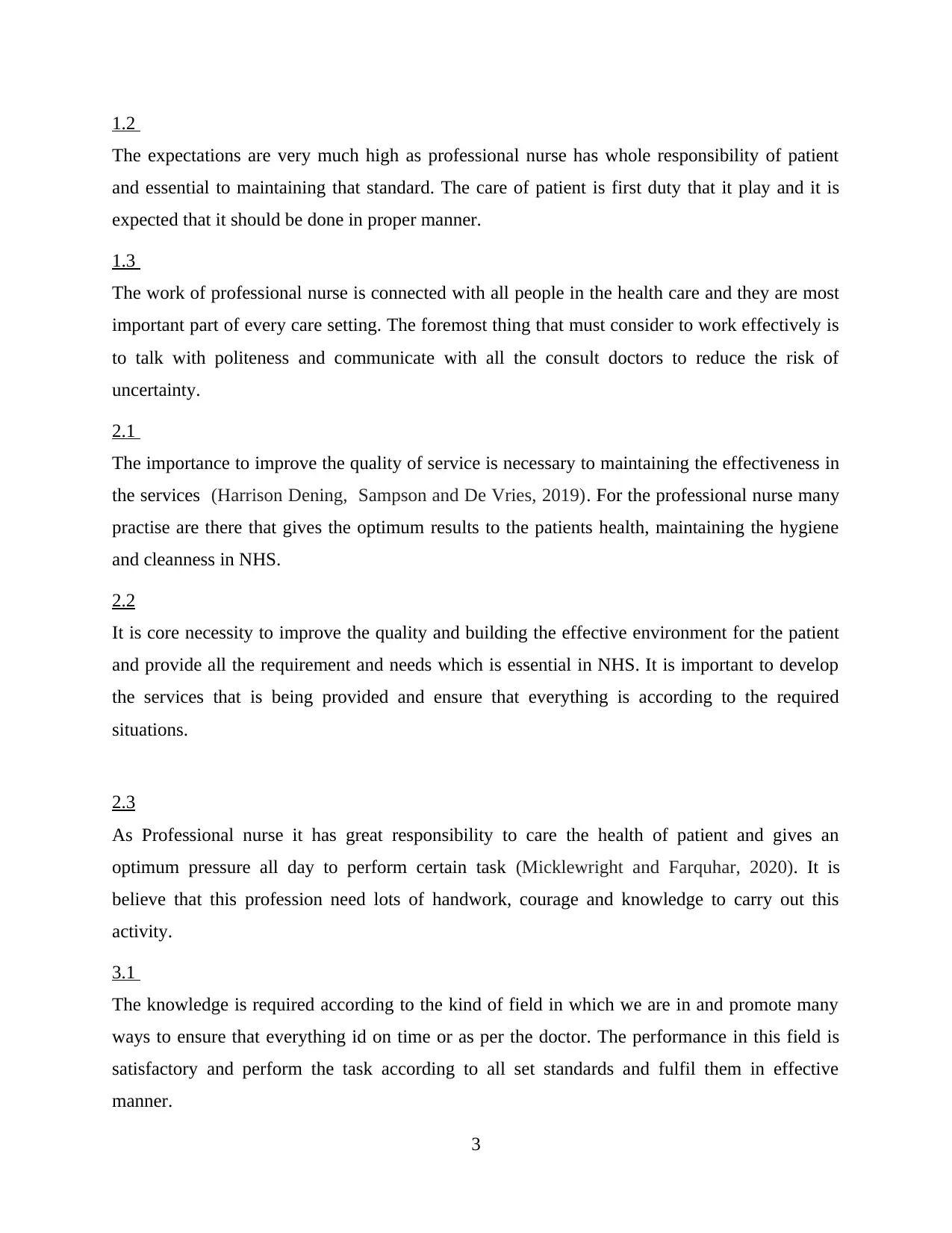
1.2
The expectations are very much high as professional nurse has whole responsibility of patient
and essential to maintaining that standard. The care of patient is first duty that it play and it is
expected that it should be done in proper manner.
1.3
The work of professional nurse is connected with all people in the health care and they are most
important part of every care setting. The foremost thing that must consider to work effectively is
to talk with politeness and communicate with all the consult doctors to reduce the risk of
uncertainty.
2.1
The importance to improve the quality of service is necessary to maintaining the effectiveness in
the services (Harrison Dening, Sampson and De Vries, 2019). For the professional nurse many
practise are there that gives the optimum results to the patients health, maintaining the hygiene
and cleanness in NHS.
2.2
It is core necessity to improve the quality and building the effective environment for the patient
and provide all the requirement and needs which is essential in NHS. It is important to develop
the services that is being provided and ensure that everything is according to the required
situations.
2.3
As Professional nurse it has great responsibility to care the health of patient and gives an
optimum pressure all day to perform certain task (Micklewright and Farquhar, 2020). It is
believe that this profession need lots of handwork, courage and knowledge to carry out this
activity.
3.1
The knowledge is required according to the kind of field in which we are in and promote many
ways to ensure that everything id on time or as per the doctor. The performance in this field is
satisfactory and perform the task according to all set standards and fulfil them in effective
manner.
3
The expectations are very much high as professional nurse has whole responsibility of patient
and essential to maintaining that standard. The care of patient is first duty that it play and it is
expected that it should be done in proper manner.
1.3
The work of professional nurse is connected with all people in the health care and they are most
important part of every care setting. The foremost thing that must consider to work effectively is
to talk with politeness and communicate with all the consult doctors to reduce the risk of
uncertainty.
2.1
The importance to improve the quality of service is necessary to maintaining the effectiveness in
the services (Harrison Dening, Sampson and De Vries, 2019). For the professional nurse many
practise are there that gives the optimum results to the patients health, maintaining the hygiene
and cleanness in NHS.
2.2
It is core necessity to improve the quality and building the effective environment for the patient
and provide all the requirement and needs which is essential in NHS. It is important to develop
the services that is being provided and ensure that everything is according to the required
situations.
2.3
As Professional nurse it has great responsibility to care the health of patient and gives an
optimum pressure all day to perform certain task (Micklewright and Farquhar, 2020). It is
believe that this profession need lots of handwork, courage and knowledge to carry out this
activity.
3.1
The knowledge is required according to the kind of field in which we are in and promote many
ways to ensure that everything id on time or as per the doctor. The performance in this field is
satisfactory and perform the task according to all set standards and fulfil them in effective
manner.
3
Paraphrase This Document
Need a fresh take? Get an instant paraphrase of this document with our AI Paraphraser

3.2
The feedback that is required to provide that is necessary and the performance that is done is up
to mark and perform certain task and responsibility that is essential in NHS. The performance is
according to the set standard and I perform as per the requirement.
4.1
Some sources that is important to plan and review of Professional nurse is become to identify the
need and requirement is developing and ensure that they provide with some sources. To develop
the plan the need to identify the sources are become essential,
4.2
The knowledge and self learning of professional nurse is analyse by properly identify the need of
improvement and maintaining the high quality service in nurse services is essential. To
reviewing the certain interest of professional nurse is increasing day by day.
4.3
Some importance personal development plan is necessary to identify to agree with other and plan
for professional plan is necessary to develop and maintaining the efficiency in workplace.
5.1
The various learning practices has been identified and need to be consider and importance to
evaluate the ways are as follows-
Maintaining the effectively relationship between all the professional in proper manner.
Developing the sense of proficiency in the profession and build the efficiency to ensure
the better services provider.
5.2
The core values of nurse is to be polite and establish effective relationship with all professional
in the organisation as it facilitate the health of patients and it require the need of it.
5.3
In every profession it is necessary to continue the personal development plan in proper way so
that an professional able to achieve its objectives and target. For professional nurse the
continuing development is essential to meet daily challenges effectively.
4
The feedback that is required to provide that is necessary and the performance that is done is up
to mark and perform certain task and responsibility that is essential in NHS. The performance is
according to the set standard and I perform as per the requirement.
4.1
Some sources that is important to plan and review of Professional nurse is become to identify the
need and requirement is developing and ensure that they provide with some sources. To develop
the plan the need to identify the sources are become essential,
4.2
The knowledge and self learning of professional nurse is analyse by properly identify the need of
improvement and maintaining the high quality service in nurse services is essential. To
reviewing the certain interest of professional nurse is increasing day by day.
4.3
Some importance personal development plan is necessary to identify to agree with other and plan
for professional plan is necessary to develop and maintaining the efficiency in workplace.
5.1
The various learning practices has been identified and need to be consider and importance to
evaluate the ways are as follows-
Maintaining the effectively relationship between all the professional in proper manner.
Developing the sense of proficiency in the profession and build the efficiency to ensure
the better services provider.
5.2
The core values of nurse is to be polite and establish effective relationship with all professional
in the organisation as it facilitate the health of patients and it require the need of it.
5.3
In every profession it is necessary to continue the personal development plan in proper way so
that an professional able to achieve its objectives and target. For professional nurse the
continuing development is essential to meet daily challenges effectively.
4
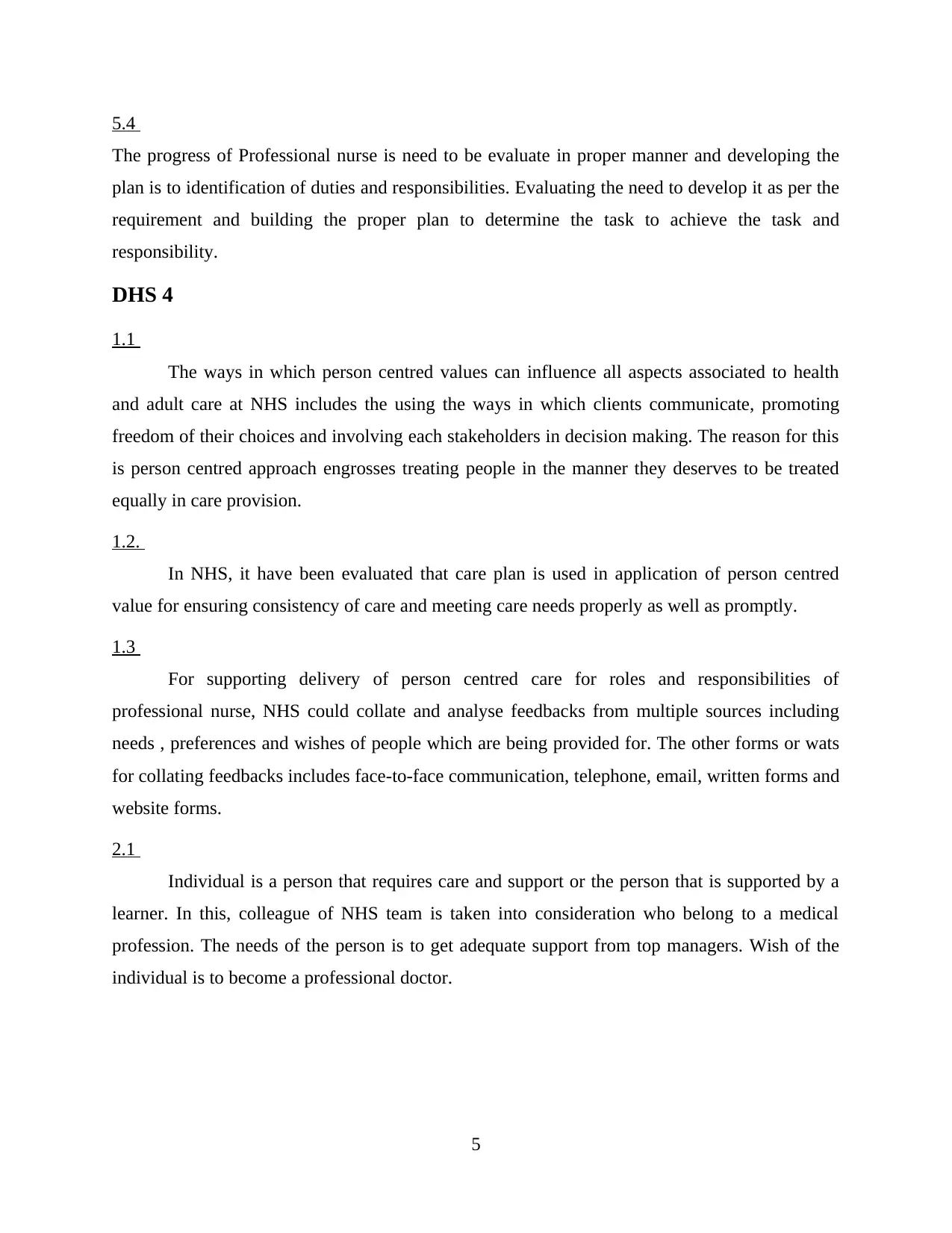
5.4
The progress of Professional nurse is need to be evaluate in proper manner and developing the
plan is to identification of duties and responsibilities. Evaluating the need to develop it as per the
requirement and building the proper plan to determine the task to achieve the task and
responsibility.
DHS 4
1.1
The ways in which person centred values can influence all aspects associated to health
and adult care at NHS includes the using the ways in which clients communicate, promoting
freedom of their choices and involving each stakeholders in decision making. The reason for this
is person centred approach engrosses treating people in the manner they deserves to be treated
equally in care provision.
1.2.
In NHS, it have been evaluated that care plan is used in application of person centred
value for ensuring consistency of care and meeting care needs properly as well as promptly.
1.3
For supporting delivery of person centred care for roles and responsibilities of
professional nurse, NHS could collate and analyse feedbacks from multiple sources including
needs , preferences and wishes of people which are being provided for. The other forms or wats
for collating feedbacks includes face-to-face communication, telephone, email, written forms and
website forms.
2.1
Individual is a person that requires care and support or the person that is supported by a
learner. In this, colleague of NHS team is taken into consideration who belong to a medical
profession. The needs of the person is to get adequate support from top managers. Wish of the
individual is to become a professional doctor.
5
The progress of Professional nurse is need to be evaluate in proper manner and developing the
plan is to identification of duties and responsibilities. Evaluating the need to develop it as per the
requirement and building the proper plan to determine the task to achieve the task and
responsibility.
DHS 4
1.1
The ways in which person centred values can influence all aspects associated to health
and adult care at NHS includes the using the ways in which clients communicate, promoting
freedom of their choices and involving each stakeholders in decision making. The reason for this
is person centred approach engrosses treating people in the manner they deserves to be treated
equally in care provision.
1.2.
In NHS, it have been evaluated that care plan is used in application of person centred
value for ensuring consistency of care and meeting care needs properly as well as promptly.
1.3
For supporting delivery of person centred care for roles and responsibilities of
professional nurse, NHS could collate and analyse feedbacks from multiple sources including
needs , preferences and wishes of people which are being provided for. The other forms or wats
for collating feedbacks includes face-to-face communication, telephone, email, written forms and
website forms.
2.1
Individual is a person that requires care and support or the person that is supported by a
learner. In this, colleague of NHS team is taken into consideration who belong to a medical
profession. The needs of the person is to get adequate support from top managers. Wish of the
individual is to become a professional doctor.
5
⊘ This is a preview!⊘
Do you want full access?
Subscribe today to unlock all pages.

Trusted by 1+ million students worldwide
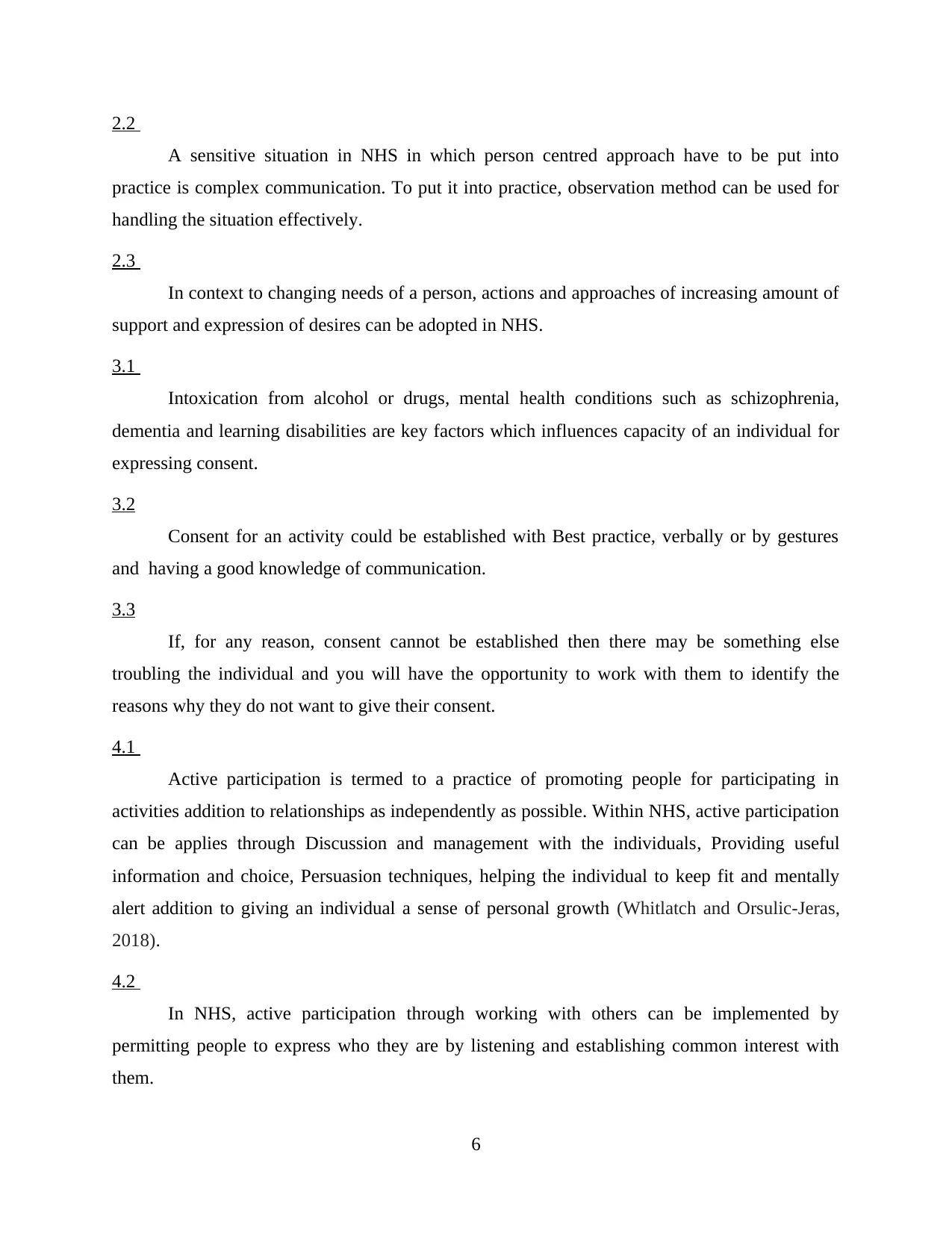
2.2
A sensitive situation in NHS in which person centred approach have to be put into
practice is complex communication. To put it into practice, observation method can be used for
handling the situation effectively.
2.3
In context to changing needs of a person, actions and approaches of increasing amount of
support and expression of desires can be adopted in NHS.
3.1
Intoxication from alcohol or drugs, mental health conditions such as schizophrenia,
dementia and learning disabilities are key factors which influences capacity of an individual for
expressing consent.
3.2
Consent for an activity could be established with Best practice, verbally or by gestures
and having a good knowledge of communication.
3.3
If, for any reason, consent cannot be established then there may be something else
troubling the individual and you will have the opportunity to work with them to identify the
reasons why they do not want to give their consent.
4.1
Active participation is termed to a practice of promoting people for participating in
activities addition to relationships as independently as possible. Within NHS, active participation
can be applies through Discussion and management with the individuals, Providing useful
information and choice, Persuasion techniques, helping the individual to keep fit and mentally
alert addition to giving an individual a sense of personal growth (Whitlatch and Orsulic-Jeras,
2018).
4.2
In NHS, active participation through working with others can be implemented by
permitting people to express who they are by listening and establishing common interest with
them.
6
A sensitive situation in NHS in which person centred approach have to be put into
practice is complex communication. To put it into practice, observation method can be used for
handling the situation effectively.
2.3
In context to changing needs of a person, actions and approaches of increasing amount of
support and expression of desires can be adopted in NHS.
3.1
Intoxication from alcohol or drugs, mental health conditions such as schizophrenia,
dementia and learning disabilities are key factors which influences capacity of an individual for
expressing consent.
3.2
Consent for an activity could be established with Best practice, verbally or by gestures
and having a good knowledge of communication.
3.3
If, for any reason, consent cannot be established then there may be something else
troubling the individual and you will have the opportunity to work with them to identify the
reasons why they do not want to give their consent.
4.1
Active participation is termed to a practice of promoting people for participating in
activities addition to relationships as independently as possible. Within NHS, active participation
can be applies through Discussion and management with the individuals, Providing useful
information and choice, Persuasion techniques, helping the individual to keep fit and mentally
alert addition to giving an individual a sense of personal growth (Whitlatch and Orsulic-Jeras,
2018).
4.2
In NHS, active participation through working with others can be implemented by
permitting people to express who they are by listening and establishing common interest with
them.
6
Paraphrase This Document
Need a fresh take? Get an instant paraphrase of this document with our AI Paraphraser

4.3
In care setting that is NHS, active participation can address holistic individual needs
through providing choice and permitting control about they ways the whole care and support
package is planned addition to delivered, leading to increase independence, self esteem, self
confidence and ultimately well-being.
4.4
For promoting understanding and usage of active participation, professionals of NHS
uses ways such as finding innovative ways, being non judgemental, working in partnership with
others and valuing diversity.
5.1
A good way of supporting an individual to make informed right is by using agreed risk
assessment processes.
5.2
Roles and authority to support rights for making choices includes creating opportunity for
others to share ideas, exchanging information, learning from each others as well as working for
common objective in care setting or NHS.
5.3
Key strategies that helps in managing risk which maintains right to make choices are
avoidance, retention, sharing, loss prevention, transferring and reduction.
5.4
In NHS, it is responsibility of a care workers to support questioning of an individual.
Application of Human Rights Act 1998 is one of effective ways to support questioning of an
individual.
6.1
Identity is all about who you are. Self esteem is related to the ways a person feel about
themselves. At same time, self image is the ways you see yourself. All these are linked to each
other.
7
In care setting that is NHS, active participation can address holistic individual needs
through providing choice and permitting control about they ways the whole care and support
package is planned addition to delivered, leading to increase independence, self esteem, self
confidence and ultimately well-being.
4.4
For promoting understanding and usage of active participation, professionals of NHS
uses ways such as finding innovative ways, being non judgemental, working in partnership with
others and valuing diversity.
5.1
A good way of supporting an individual to make informed right is by using agreed risk
assessment processes.
5.2
Roles and authority to support rights for making choices includes creating opportunity for
others to share ideas, exchanging information, learning from each others as well as working for
common objective in care setting or NHS.
5.3
Key strategies that helps in managing risk which maintains right to make choices are
avoidance, retention, sharing, loss prevention, transferring and reduction.
5.4
In NHS, it is responsibility of a care workers to support questioning of an individual.
Application of Human Rights Act 1998 is one of effective ways to support questioning of an
individual.
6.1
Identity is all about who you are. Self esteem is related to the ways a person feel about
themselves. At same time, self image is the ways you see yourself. All these are linked to each
other.
7
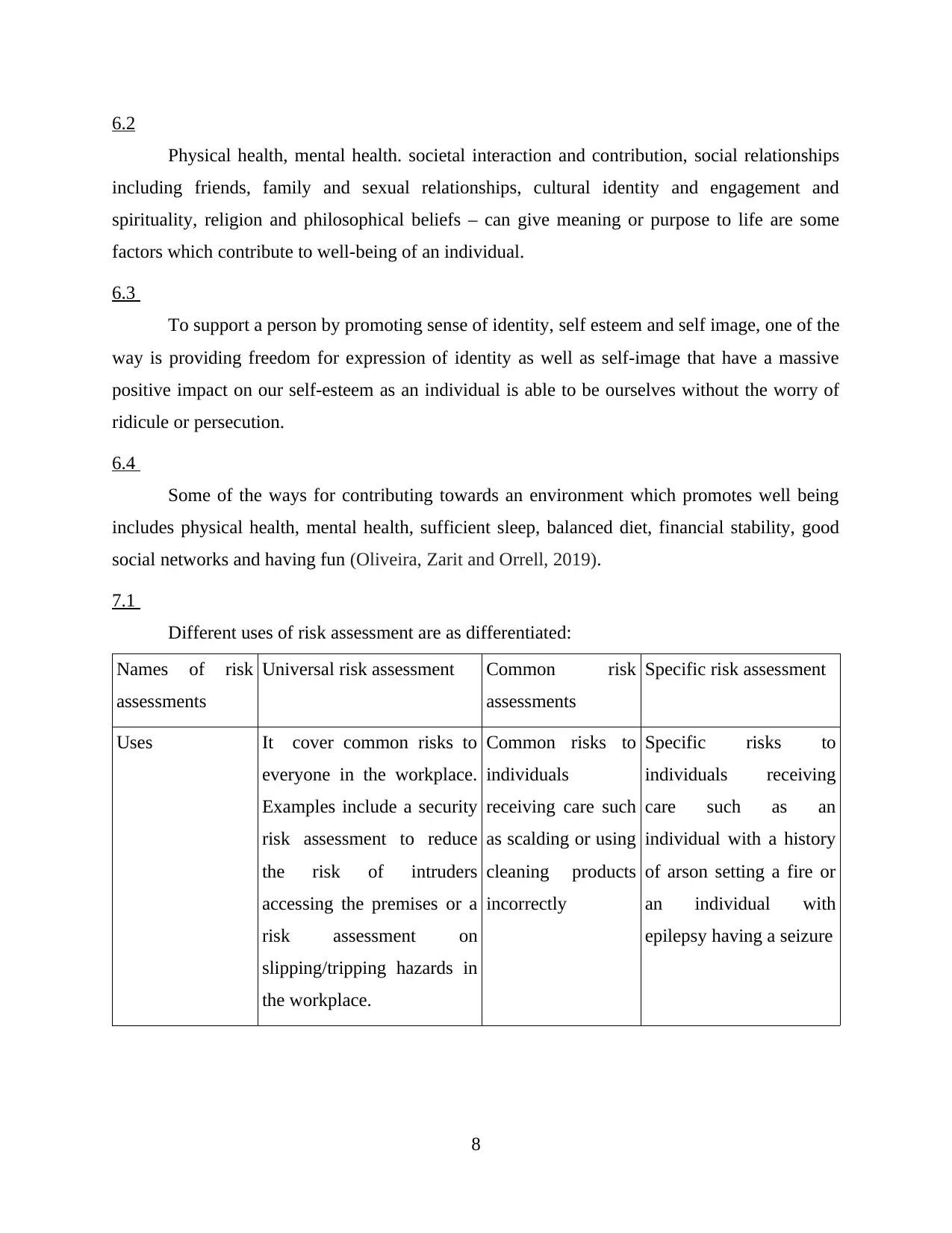
6.2
Physical health, mental health. societal interaction and contribution, social relationships
including friends, family and sexual relationships, cultural identity and engagement and
spirituality, religion and philosophical beliefs – can give meaning or purpose to life are some
factors which contribute to well-being of an individual.
6.3
To support a person by promoting sense of identity, self esteem and self image, one of the
way is providing freedom for expression of identity as well as self-image that have a massive
positive impact on our self-esteem as an individual is able to be ourselves without the worry of
ridicule or persecution.
6.4
Some of the ways for contributing towards an environment which promotes well being
includes physical health, mental health, sufficient sleep, balanced diet, financial stability, good
social networks and having fun (Oliveira, Zarit and Orrell, 2019).
7.1
Different uses of risk assessment are as differentiated:
Names of risk
assessments
Universal risk assessment Common risk
assessments
Specific risk assessment
Uses It cover common risks to
everyone in the workplace.
Examples include a security
risk assessment to reduce
the risk of intruders
accessing the premises or a
risk assessment on
slipping/tripping hazards in
the workplace.
Common risks to
individuals
receiving care such
as scalding or using
cleaning products
incorrectly
Specific risks to
individuals receiving
care such as an
individual with a history
of arson setting a fire or
an individual with
epilepsy having a seizure
8
Physical health, mental health. societal interaction and contribution, social relationships
including friends, family and sexual relationships, cultural identity and engagement and
spirituality, religion and philosophical beliefs – can give meaning or purpose to life are some
factors which contribute to well-being of an individual.
6.3
To support a person by promoting sense of identity, self esteem and self image, one of the
way is providing freedom for expression of identity as well as self-image that have a massive
positive impact on our self-esteem as an individual is able to be ourselves without the worry of
ridicule or persecution.
6.4
Some of the ways for contributing towards an environment which promotes well being
includes physical health, mental health, sufficient sleep, balanced diet, financial stability, good
social networks and having fun (Oliveira, Zarit and Orrell, 2019).
7.1
Different uses of risk assessment are as differentiated:
Names of risk
assessments
Universal risk assessment Common risk
assessments
Specific risk assessment
Uses It cover common risks to
everyone in the workplace.
Examples include a security
risk assessment to reduce
the risk of intruders
accessing the premises or a
risk assessment on
slipping/tripping hazards in
the workplace.
Common risks to
individuals
receiving care such
as scalding or using
cleaning products
incorrectly
Specific risks to
individuals receiving
care such as an
individual with a history
of arson setting a fire or
an individual with
epilepsy having a seizure
8
⊘ This is a preview!⊘
Do you want full access?
Subscribe today to unlock all pages.

Trusted by 1+ million students worldwide
1 out of 14
Related Documents
Your All-in-One AI-Powered Toolkit for Academic Success.
+13062052269
info@desklib.com
Available 24*7 on WhatsApp / Email
![[object Object]](/_next/static/media/star-bottom.7253800d.svg)
Unlock your academic potential
Copyright © 2020–2025 A2Z Services. All Rights Reserved. Developed and managed by ZUCOL.





